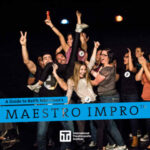SET IT UP!
 How do you teach a game in class, or set up a show or scene in front of an audience successfully? Are you connecting or confusing your audience? An effective beginning to the show or exercise can make all the difference.
How do you teach a game in class, or set up a show or scene in front of an audience successfully? Are you connecting or confusing your audience? An effective beginning to the show or exercise can make all the difference.
Here are some tips and tricks to help you and your audience move forward efficiently in the classroom and on stage.
— OPEN WITH ELEGANCE —
As a teacher or performer, elegance is your ally. Clearly presented ideas expressed in the fewest number of words will have the greatest impact.
If you’ve ever been to a show that opened with a 15 minute explanation leaving you more confused than enlightened, you’ll know what I’m saying.
For a quick exploration into elegant and complicated setups you have no further to look than the board game or card game you keep in the closet.
For longer than any of us have been alive, card games and board games have existed. The creation of THE SETUP has been honed by the creators of some of these games. The “How to Play” description in every game is a great resources in understanding how you present your exercise or format.
 Trivial Pursuit is a trivia game where you try to answer more questions in various categories to reach the goal before your opponent.
Trivial Pursuit is a trivia game where you try to answer more questions in various categories to reach the goal before your opponent.
That was simply put. You know what you are getting into.
Unfortunately, in my version of the game there is a confusing description which talks about the winner being “the first player to return to a hexagonal hub” without ever mentioning what’s going on or why we would even consider a hexagonal hub relevant.
Online, I found another opening sentence for the game that looks like this:
The goal is To be the first player (or team) to fill all six spaces on your Scoring Token with different colored wedges by correctly answering questions.
Brilliant. That’s not complicated and it gives me a basic place to start. It’s a fairly elegant statement that frames everything I’m about to learn about the game. I answer questions. I score tokens. I complete a task that has 6 parts. I do this first. I win.
Another way of looking at it is to learn how to GENERALIZE effectively. Yes, technically they are “Hexagonal Hubs” but the majority of people would connect more quickly to the concept of “scoring token” or “playing piece”. Start simple and then move towards specific and detailed.
Create accessibility for your audience and then make them work with what you are giving them.
In a format called THE HOT SEAT – we explore the introduction every time we do the show. Before the pandemic, we distilled our opening to this: 
“Welcome to THE HOT SEAT. This improvised show has 4 directors competing for your approval as they direct scenes that you want to see.”
That’s the base. We know who’s doing what and we know how it is SUPPOSED to affect the audience. Later, the details will fill in HOW the goal will be achieved, WHAT process they will follow and WHO they are.
— Don’t say it all – Say what is needed. —
As a teacher, I’ve learned a lot of interesting tips, tricks and pitfalls for exercises I teach on a regular basis. I’d love to be able to pass all of these gems on to the students. I know, however, that by passing on too much at one time I will overload the student and destroy their experience. Letting students and the audience discover the important information at the right time is a key to effective presentation.
In the HOT SEAT format, the second half of the show differs from the first half. The players “battle” each other directly in a way that didn’t occur in the first part of the show.
If we open the show by telling the audience everything, including this ending sequence, they have a lot of useless information interfering with their experience of how things start.
What is important RIGHT NOW?
 What’s important should be at the top of your mind and should be your focus. It’s easy to tell the punchline of a joke for example but you know that won’t benefit the humour if the setup is incomplete.
What’s important should be at the top of your mind and should be your focus. It’s easy to tell the punchline of a joke for example but you know that won’t benefit the humour if the setup is incomplete.
If you communicate the information needed for each moment, it should act like a scaffold on which every new piece of information is built.
I remember a time the audience reacted with spontaneous emotions in the setup of the Hot Seat. I told the audience why the points in the competition mattered, explaining that if a player fails to score at least one point by intermission, they would be eliminated from the competition.
There was a genuine emotional reaction as if audience members had been jabbed sharply in the ribs. I forgot what I was about to say because the reaction was so unexpected – but it made an impact and great reminder that the set-up for your show or exercise is a story that needs to follow the right order.
A good introduction encourages the audience to invest into what is about to happen in front of them.
It’s the same in the classroom when the exercise unfolds elegantly encouraging those “A-HA!!” moments as the students make the connections that the lesson is delivering.
In the card game EXPLODING KITTENS, the instructions simplify the process by saying :
 – take turns revealing cards until someone reveals an exploding kitten.
– take turns revealing cards until someone reveals an exploding kitten.
– When that happens the player is out of the game
– the process continues until there’s only one player left.
– all other cards in the deck lessen the chance of getting exploded by exploding kittens.
Of course we know that the game is more complicated. We just don’t need to know ALL of the complications right away. With the card game, every new rule comes easily because it is revealed only when necessary.
— Answer the questions on everyone’s mind and GIVE EXAMPLES —
There will be basic questions on everyone’s minds. Answer those.
In The HOT SEAT format, the audience knows that the directors are trying to create scenes that the audience likes, but how do we figure this out? A vote? How will that happen? What’s my role as an audience member?
Explain the relevant details and give them examples. Get the students or audience to practice their roles. These elements create safety and encourage a good attitude for the participants. If your audience is supposed to scream in the show. Have them scream in your setup. If the students are supposed to interrupt each other in an exercise, have them practice that.
More than just “getting it right” you are giving permission for people to act unnaturally. We don’t normally scream and interrupt in public. We have to create permission for these unnatural acts to occur.
 In Keith Johnstone’s MAESTRO format, we have the audience practice voting for scenes on a scale of 1-5, rating the worth of the scene they watch. If the setup is poorly done, audiences feel hesitant to vote for the extreme ends of the scale. They haven’t been given the safety to express themselves and so they mostly applaud in a safe middle range.
In Keith Johnstone’s MAESTRO format, we have the audience practice voting for scenes on a scale of 1-5, rating the worth of the scene they watch. If the setup is poorly done, audiences feel hesitant to vote for the extreme ends of the scale. They haven’t been given the safety to express themselves and so they mostly applaud in a safe middle range.
In a warm up game in class with students where people run after each other and follow specific rules of engagement, I ask them in a practice round to run in slow motion as we display what we know about the game. This allows for the physical people to practice while the verbal people can speak about what is happening without the chaos of the actual game.
BY TEACHING THROUGH EXAMPLE, YOU ADDRESS THOSE WHO NEED TO LEARN BY EXPERIENCE.
In every class, the same patterns of behaviour occur:
– Someone will ask about the finite details of an exercise.
– I will suggest that we try what we know before we talk more about it.
-Without fail, everyone understands the game by doing it and there are no more questions.
So much of our learning is focused on verbal, intellectual understanding that we forget about the people who need to “DO IT to learn it”. Instead of torturing the physical people with more words, force the verbal people to PLAY and to DO.
— REVEAL INFORMATION AS YOU GO — Remember how you held back some of that information during the instructions? Make sure you reveal relevant information as it becomes important.
Remember how you held back some of that information during the instructions? Make sure you reveal relevant information as it becomes important.
Revealing new information or clarifying existing information is like going back to those instruction pages in the board game to discover what the special card in the deck does when you play it, or what happens when all the scoring tokens are gone. It moves us forward and connects us in clear understanding.
In the HOT SEAT, there might come a time where the show is nearing the end of the first half and not all of the directors have had the chance to direct. In the middle of one show, I had a “60 second” rule prepared to deal with this.
As the host, I addressed the audience and said,
“We have only five minutes before intermission at which time the directors who have not scored a point will be eliminated, so let’s end the first half of the show with a section called – THE LAST CHANCE. Directors who haven’t directed get to direct 60 second scenes to see if they can score a point and move into the second half.”
The audience had become used to the rules that we’d been following for 45 minutes. The new information didn’t conflict with what they understood. So new information halfway through their experience enhanced the game by reminding them of what was at stake.
There’s no effort to incorporate the additional rules when they are elegant and benefit the exercise. New elegant information creates some excitement as improvisation should do.
An important reminder: make sure you haven’t held back important information at the start when you set up your exercise or format. No one likes having the basic rules changed arbitrarily because of a poor setup. It breaks the trust of the participants.
Extra:
– Don’t assume that your audience knows it all. Teachers and performers get lazy when setting things up especially if they’ve done it many times before.
– Imagine hearing yourself through the ears of your newest student or audience member and ask yourself if you’ve made things clear for them. Give them a fair chance to connect in the way that the rest of the audience is connecting.
– Express yourselves for three kinds of people:
Verbal, Physical and Auditory.
Speak it, show it, do it.




0 Comments